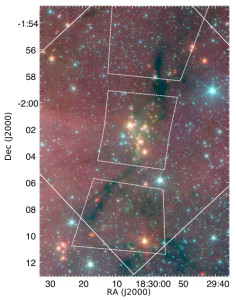New paper on the Star Formation Region Serpens South

“YSOVAR: Mid-infrared Variability among YSOs in the Star Formation Region Serpens South”
We present a time-variability study of young stellar objects (YSOs) in the Serpens South cluster performed at 3.6 and 4.5 μm with the Spitzer Space Telescope; this study is part of the Young Stellar Object VARiability project. We have collected light curves for more than 1500 sources, including 85 cluster members, over 38 days. This includes 44 class I sources, 19 sources with flat spectral energy distributions (SEDs), 17 class II sources, and five diskless YSO candidates. We find a high variability fraction among embedded cluster members of ∼70%, whereas young stars without a detectable disk display no variability. We detect periodic variability for 32 sources with periods primarily in the range of 0.2–14 days and a subset of fast rotators thought to be field binaries. The timescale for brightness changes are shortest for stars with the most photospheric SEDs and longest for those with flat or rising SEDs. While most variable YSOs become redder when fainter, as would be expected from variable extinction, about 10% get bluer as they get fainter. One source, SSTYSV J183006.13‑020108.0, exhibits “cyclical” color changes.
“YSOVAR: Mid-infrared Variability among YSOs in the Star Formation Region Serpens South”, Wolk, Scott J.; Günther, H. Moritz; Poppenhaeger, Katja; Winston, E.; Rebull, L. M.; Stauffer, J. R.; Gutermuth, R. A.; Cody, A. M.; Hillenbrand, L. A.; Plavchan, P.; Covey, K. R.; Song, Inseok, The Astronomical Journal, Volume 155, Issue 2, article id. 99, 20 pp. (2018).